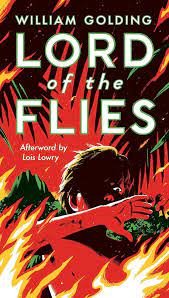The story opens with the boys’ arrival on the island, where they elect Ralph as their leader, with the intellectual Piggy as his adviser. Ralph’s initial attempts to maintain order and civility are symbolized by the conch shell, used to call meetings and uphold democratic processes. However, Jack, the head of the choirboys turned hunters, becomes increasingly obsessed with hunting and power, challenging Ralph’s authority and advocating for a more primal existence focused on survival and the hunt.
The boys’ fear of a supposed beast on the island exacerbates their descent into savagery. Simon, a sensitive boy who questions the group’s fear, discovers that the beast is, in fact, a dead parachutist from a nearby plane crash. However, when he attempts to reveal this truth, he is brutally killed by the boys in a frenzied ritual dance. This marks a turning point, leading to further violence and the complete breakdown of social order.
Ralph and Piggy’s attempts to restore order are futile, and the conflict with Jack’s faction escalates. The novel reaches its climax with the murder of Piggy and the hunters’ relentless pursuit of Ralph, intending to kill him. The narrative concludes with the arrival of a naval officer, who rescues the boys. The sight of the officer prompts a sudden return to civilization’s reality, and the boys, confronted with the consequences of their actions, break down in tears.
Character Analysis
- Ralph: Represents order, leadership, and civilization. Ralph's struggle to maintain calm and rational governance on the island mirrors the challenges of establishing and upholding democratic principles.
- Piggy: Symbolizes intellect and reason. Despite his valuable insights, Piggy's physical appearance and lack of charisma make him an outsider, illustrating the fragile nature of wisdom and rationality in the face of mob mentality.
- Jack: Embodies savagery, the lust for power, and the primal instincts within humanity. His character's evolution from a disciplined choirboy to a ruthless tribal leader highlights the ease with which civilized behavior can be shed.
- Simon: Represents innocence and the moral compass of the group. Simon's interactions with the natural world and his eventual death underscore the novel's themes of the loss of innocence and the inherent evil within humanity.
One of the novel's most poignant quotes is by Piggy: "Which is better – to have rules and agree, or to hunt and kill?" This question encapsulates the central conflict of the novel, the tension between civilization and savagery, and the choices that define our humanity.
In conclusion, “Lord of the Flies” by William Golding offers a bleak yet insightful commentary on the human condition. Through the microcosm of a society of stranded boys, Golding explores profound questions about the nature of evil, the complexities of leadership, and the fragile veneer of civilization. The novel remains a compelling study of the darkness that lies within each person and the societal constructs that hold this darkness at bay.
If the summary caught your interest,
Consider reading the full book on AbeBooks.
Explore this book on AbeBooks
